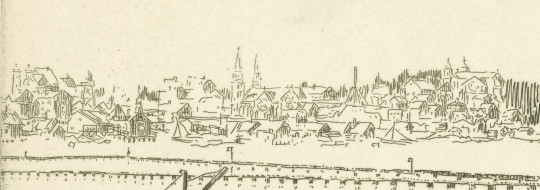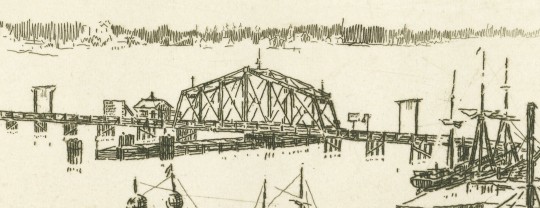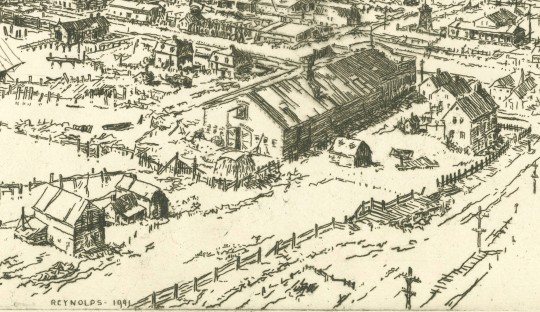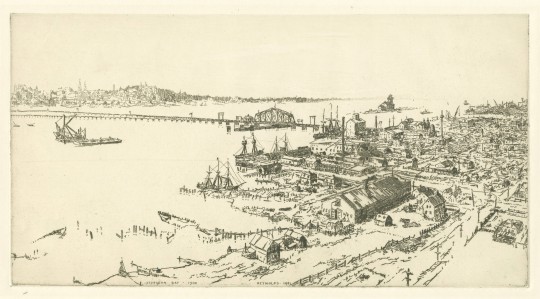#Old Sturgeon Bay 1900
Text








Old Sturgeon Bay, Wisconsin, 1900
Wisconsin architect and printmaker Charles Clark Reynolds (1893-1969) produced this etching of the Door County port city of Sturgeon Bay for the Federal Art Project of the WPA in 1941. Reynolds, who was born in Sturgeon Bay, ran a successful architectural firm with offices in Manitowoc and Green Bay, Wisconsin from 1920-1934. Andrew Stevens, curator emeritus of prints, drawings and photographs at the Chazen Museum of Art at the University of Wisconsin-Madison, made these observations about another copy of the print at the Wisconsin Historical Society in his 1998 exhibition catalog, 150 Years of Wisconsin Printmaking:
The print's title and the notation on the plate that identifies the image as being "Sturgeon Bay 1900" suggest a nostalgic purpose for the work. Instead of presenting the city as it was when the print was made in 1941, he looked back forty years, perhaps by reference to photography, to present if at the turn of the century [as Reynolds himself would have known it as a boy]. As if to reference further the retrospective stance of the work, there is a pencil notation in the print's margin that identifies it as having been printed on antique paper. This retrospective aspect of the work . . . may also reflect some of the historical goals of other projects of the WPA.
Our copy of the print is part of a portfolio of prints from the Wisconsin WPA, and this image is from a digitized version of that print from our digital collection Wisconsin Arts Projects of the WPA, which was made possible with generous financial support from The Chipstone Foundation.
View other posts on prints by Charles Reynolds.
View more posts from our Wisconsin Arts Projects digital collection.
#Old Sturgeon Bay 1900#Sturgeon Bay#Wisconsin#etchings#Charles Reynolds#Charles Clark Reynolds#Federal Art Project#Works Progress Administration#WPA#Wisconsin Arts Projects of the WPA#Andrew Stevens#digital collections#intaglio prints#Wisconsin artists
65 notes
·
View notes
Text
Angler Catches Super-Rare 'Dinosaur' Fish in Kansas River, Throws It Back
— By Pandora Dewan | December 11, 2022 | Newsweek

Kevin Zirjacks is seen with the rare lake sturgeon he caught in the Kansas River. After taking the photos, he returned the endangered fish back into the water. Kevin ZirJacks/Kansas Wildlife and Parks
An extremely rare species of fish was recently caught in the Kansas River by an angler. This was only the 16th reported catch of the endangered lake sturgeon in Kansas in over 25 years, the state's Department of Wildlife and Parks said.
The department shared the news of the catch in a post on Facebook. "I knew I had a special fish once I landed this fish," fisherman Kevin Zirjacks said in response to the post. "Never thought I would ever see one of these dinosaurs, let alone be able to actually hold one. Definitely a catch I will remember for the rest of my life."
After taking photos with the fish, Kirjacks released it back into the water.
Lake sturgeon can be found throughout North America, from Hudson Bay to the Mississippi River. They are the oldest and largest species native to the Great Lakes, first appearing in the fossil record about 135 million years ago, 70 years before the dinosaurs went extinct.
Lake sturgeon themselves can live very long lives, with females reportedly living for as long as 150 years, the National Wildlife Federation said. They are also massive, growing up to 6.5 feet long and weighing up to 200 pounds.
Before the 19th century, lake sturgeon were abundant throughout the Great Lakes. However, overfishing in the 1800s and 1900s dramatically reduced their populations. Today, the species is dwindling in its northern territories, and it is considered endangered in the southern parts of its range.
Efforts to reintroduce this freshwater fish have been slow because of their long life cycle. Females usually do not start producing eggs until they are at least 20 years old.
Zirjacks detailed how he used special equipment to avoid injuring the endangered fish. "The green thing is an unhooking cradle," he said, referring to the green tarpaulin seen in his photograph. "It's a great tool when catch and release fishing. Gives you a padded place to put your fish after landing them.
"It's raised off the ground to keep them nice and clean.... Makes handling the fish way easier and lets you get them back in the water quicker. Really comes in handy when handling bigger fish," he said.
While efforts continue to attempt to revive this population, the lake sturgeon is facing other environmental threats. Water pollution and invasive aquatic species have made their habitats less hospitable, and climate change is expected to decrease the quality and quantity of nursery and spawning sites and exacerbate existing problems.
0 notes
Photo

CANOE: Great Canadian Design 3 Designed by Indigenous peoples of North America.
From the indigenous people who lived in what is now Canada, to the early explorers, tradesmen, adventurers, voyageurs to todays enthusiast, the canoe is as quintessential a symbol of Canada, its identity as it is a masterpiece of economic design.
They were usually skinned with birch bark over a light wooden frame, but other types could be used if birch was scarce. At a typical length of 4.3 m (14 ft) and weight of 23 kg (50 lb), the canoes were light enough to be portaged, yet could carry a lot of cargo, even in shallow water. Although susceptible to damage from rocks, they are easily repaired. Their performance qualities were soon recognized by early European immigrants, and canoes played a key role in the exploration of North America, with Samuel de Champlain canoeing as far as the Georgian Bay in 1615. René de Bréhant de Galinée a French missionary who explored the Great Lakes in 1669 declared: “The convenience of these canoes is great in these waters, full of cataracts or waterfalls, and rapids through which it is impossible to take any boat. When you reach them you load canoe and baggage upon your shoulders and go overland until the navigation is good; and then you put your canoe back into the water, and embark again. American painter, author and traveler George Catlin wrote that the bark canoe was "the most beautiful and light model of all the water crafts that ever were invented.”
.
Native American groups of the north Pacific coast made dugout canoes in a number of styles for different purposes, from western red-cedar (Thuja plicata) or yellow-cedar (Chamaecyparis nootkatensis), depending on availability.Different styles were required for ocean-going vessels versus river boats, and for whale-hunting versus seal-hunting versus salmon-fishing. The Quinault of Washington State built shovel-nose canoes, with double bows, for river travel that could slide over a logjam without portaging. The Kootenai of British Columbia province made sturgeon-nosed canoes from pine bark, designed to be stable in windy conditions on Kootenay Lake.
The first explorer to cross the North American continent, Alexander Mackenzie, used canoes extensively, as did David Thompson and the Lewis and Clark Expedition.
In the North American fur trade the Hudson’s Bay Company’s voyageurs used three types of canoe:
The rabaska or canot du maître was designed for the long haul from the St. Lawrence River to western Lake Superior. Its dimensions were: length approximately 11 m (35 ft), beam 1.2 to 1.8 m (4 to 6 ft), and height about 76 cm (30 in). It could carry 60 packs weighing 41 kg (90 lb), and 910 kg (2,000 lb) of provisions. With a crew of eight or ten (paddling or rowing), they could make three knots over calm waters. Four to six men could portage it, bottom up. Henry Schoolcraft declared it “altogether one of the most eligible modes of conveyance that can be employed upon the lakes.” Archibald McDonald of the Hudson’s Bay Company wrote: “I never heard of such a canoe being wrecked, or upset, or swamped … they swam like ducks.”
The canot du nord (French: “canoe of the north”), a craft specially made and adapted for speedy travel, was the workhorse of the fur trade transportation system. About one-half the size of the Montreal canoe, it could carry about 35 packs weighing 41 kg (90 lb) and was manned by four to eight men. It could be carried by two men and was portaged in the upright position.
The express canoe or canot léger, was about 4.6 m (15 ft) long and were used to carry people, reports, and news.
The birch bark canoe was used in a 6,500 kilometres (4,000 mi) supply route from Montreal to the Pacific Ocean and the Mackenzie River, and continued to be used up to the end of the 19th century.
Also popular for hauling freight on inland waterways in 19th Century North America were the York boat and the batteau.
In 19th-century North America, the birch-on-frame construction technique evolved into the wood-and-canvas canoes made by fastening an external waterproofed canvas shell to planks and ribs by boat builders Old Town Canoe, E.M. White Canoe, Peterborough Canoe Company and at the Chestnut Canoe Company in New Brunswick.
Although canoes were once primarily a means of transport, with industrialization they became popular as recreational or sporting watercraft. John MacGregor popularized canoeing through his books, and in 1866 founded the Royal Canoe Club in London and in 1880 the American Canoe Association. The Canadian Canoe Association was founded in 1900, and the British Canoe Union in 1936.
- wikipedia
2 notes
·
View notes
Text
New York City- Urban Wildlife
Wildlife NYC- website has common animals, broken down by accessible list, includes how to interact with them in your environment and behavioral patterns.
Stopping the Feeding of Animals at Parks:
First, there’s the problem that the animals may become dependent on human feeding with the result that it adversely affects the foraging behavior of the animals, causing them to become less active, deterring them from seeking out more natural foods.
Urban wildlife who are fed a diet of moldy bread, potato chips, French fries and ice cream will suffer from serious vitamin deficiencies, reduced immunity and increase susceptibility to infection.
Interactive Map of NYC Wildlife by Month- also includes breakdown by places
Botanical Garden list of wild animals. The list differs slightly from the NYC Parks list and includes rabbits, foxes, skunks.
How Climate Change Affects Animal Extinction in NYC
They found that local extinctions happened because of changes in how the animals used and interacted with their environment, not because of temperature changes. For example they found that: Reduced food availability led to local extinctions of three birds — a plover, a jay, and an auklet; A spreading deadly fungus killed off multiple species of tropical frog; drought killed off a local type of aloe tree and four amphibians; and lower oxygen availability in warmer waters killed off a fish.
Effects of New York City in Climate Change: “Living on Earth” Steve Erwood MP3
Jamaica Bay marshes are over 1,000 years old; if marshes disintegrate then hundreds of species will be affected. MTA flooding, etc
Jamaica Bay Eco Watchers (further research)
Ocean rise by at least 3 feet; costal areas can end up underwater
Short + Comprehensive FactSheet of Climate Change Effects on NY
Falling lake levels by at least 5 feet
Decrease in air quality due to increase in heat exacerbating urban pollution
20% increase in forest fires
Video: Climate Change Effects on Natural City Areas
How Climate Change Affects New York City’s Plants and Animals: Comprehensive breakdown!
In Long Island Sound, fishermen are now catching scup, black sea bass, summer flounder and northern kingfish, warmer water species that were uncommon years ago when the catch was mainly winter flounder, cod, bluefish and striped bass. Good premise for the beginning of the TV series- new animals move in, but why?
In the last several decades, many North American plants and animals have moved approximately 36 feet to higher elevations or 10.5 miles to higher latitudes every 10 years. New environments are often less hospitable for the species entering them as there might be less space or more competition for food. Some species may be moving as far they can go if they are on top of a mountain or hemmed in by some obstruction. A recent study found that almost 50 percent of species that move to a cooler environment end up going extinct.
Long term vision: By the 2080s, average temperatures in the New York metropolitan region could go up 8.8˚F, precipitation could increase 13 percent, and heat waves in New York City could triple. Sea levels around the city, which have risen a little over one foot since 1900, could rise 39 inches by the 2080s and possibly 6 feet by 2100.
Species at risk: Saltmarsh sparrows are in danger of decline since wetlands are especially vulnerable to climate change. Recovering species such as egrets and peregrine falcons could become vulnerable again; and the red knot, a shorebird, might soon disappear altogether. Eastern Tiger Salamander; Spruce Grouse; Shortnose, Lake and Atlantic Sturgeon and Bog Turtle. York is expected to lose its spruce-fir forests in the Catskills and Adirondack Mountains by 2100. (What effect might this have on the quality of New York City’s water supply that depends on the natural filtration processes of the ecosystem in that region?) Besides the spruce and fir trees, sugar maple, beech and birch forests as well as elm, ash and cottonwood forests are moving north, while hardwoods like oak and hickory, as well as invasive plants, are moving in.
The warmer winters and longer growing seasons are helping pests, pathogens and invasive plants proliferate (many weed species thrive with higher concentrations of CO2 in the atmosphere). “Warmer temperatures accelerate insect biology. Warmer seasons cause insects to grow faster, produce larger individuals which produce more eggs and more babies, and should give them a longer feeding season.”
Fish in Long Island Sound are responding to the impacts of climate change as well as to ocean acidification and human activities such as pollution and shoreline development.
In response to all the dread in this article. Here is a report that lists all the ways we can respond to climate change.
PRIORITIES FOR FURTHER RESEARCH:
One NYC 2050: A livable climate
NYC Nature Goals 2050
Community Wildlife Habitat
U.N Report on Effects of Humans on Plant + Reccs
Bring Wildlife Back to the City
Bees in Offices as a Solution
0 notes
Text
Here you go
Q: How did “Here you go” come to mean “Here is the thing you wanted”?
A: “Here you go,” an idiomatic expression that showed up in writing in the 1800s, is a casual way of saying “Here it is” when you give someone something that’s requested.
That’s why an easygoing barista says “here you go” rather than the more formal “here it is” when he hands you a mocha latte that you asked for.
Like other idioms, “here you go” is not meant literally and doesn’t even make sense on a literal level. But it’s so common that most of us don’t stop to think about it.
We haven’t seen much linguistic scholarship about the expression, though the British linguist Michael Fortescue comments briefly about “here you go” in Semantix, a 2014 book about semantics and pragmatics.
In discussing how the verb “go” has evolved in meaning and usage over the years, he says “here you go” reflects “the gradual historical bleaching of the original motion sense of the verb as it gradually became more grammaticalized.”
Grammaticalization is a process in which lexical terms acquire new grammatical functions over time. In the idiomatic expression “here you go,” Fortescue writes, “there is of course nothing left of any of the original meaning of ‘go’ at all.”
As we’ve said, “here you go” has been used in writing since the 19th century to mean “here it is.” In searches of newspaper databases, the earliest example we’ve found is from a short story in the Dec. 25, 1879, issue of the Door County Advocate in Sturgeon Bay, WI.:
“ ‘You’ve both won the heat, race, and money. Here you go,’ and he tipped the two lads handsomely.” (The speaker gives the boys, who have tied in a race, a “five-dollar piece” each.)
And this example (from the Oct. 15, 1885, Daily Yellowstone Journal in Montana) is in a joke about an elderly man asking for a light from a child’s cigar:
“Old gentleman, full of fun, to infant of eight summers, who is smoking a cigar—Can I trouble you for a light mister?
“Infant of eight summers—Here you go my boy, but be sure you give me back the right one.”
Since 1900, sightings of “here you go” used in the sense of “here it is” have become much more common.
Cambridge Dictionaries says “here you go” means “this is the object you asked me to give you.” It uses this example: “Would you please pass the sugar?’ ‘Here you go.’ ”
The Macmillan Dictionary and The Longman Dictionary of Contemporary English have similar definitions.
Dictionaries also include three similar idiomatic expressions that can be used the same way: “here you are,” “there you go,” and “there you are.”
Some dictionaries label these expressions informal or colloquial. One grammar book, English Grammar Today (2016), by Ronald Carter et al, considers the “go” versions more informal than the “are” ones:
“We can use here you are and there you are (or, in informal situations, here you go and there you go) when giving something to someone. Here and there have the same meaning in this use.”
A more scholarly grammar book, A Comprehensive Grammar of the English Language, by Randolph Quirk et al., says in a footnote that “here [or there] you are” when used in this sense is equivalent to “this is for you.” (It adds that “there you are” has an additional idiomatic meaning: “That supports or proves what I’ve said.”)
The Oxford English Dictionary, an etymological dictionary based on historical evidence, doesn’t discuss “here you go” in its entry for the verb “go,” which was revised in 2015 and now includes 603 senses of the word.
However, the OED does refer to the “are” version, saying that “here we [or you] are” can mean “Here is what we [or you] want.” The usage is labeled colloquial.
The dictionary’s only example is from the mid-19th century: “Hum! ha! now let’s see, here we are—the ‘G-i-a-o-u-r’—that’s a nice word to talk about.” (From Frank Fairlegh, an 1850 novel by Francis Edward Smedley. The noun “giaour” is a derogatory term for a non-Muslim.)
In that example, however, there’s no sense of one person presenting another with a physical item, like the barista offering you your coffee.
And the OED defines “there you are” as drawing attention to a completed action (not to a physical thing) or as meaning “What did I tell you?” or “expressing resignation to an unpleasant fact.”
Help support the Grammarphobia Blog with your donation.
And check out our books about the English language.
from Blog – Grammarphobia https://www.grammarphobia.com/blog/2018/03/here-you-go.html
0 notes
Photo



Milwaukee Handicraft Monday
Autumn in Wisconsin: we never know what we’re going to get weather-wise in Wisconsin during the fall season. The month of October is usually a last chance to get in snow-free hikes through the prairies and forests. And, while Wisconsin road trips “Up North” or to Door County are usually most popular in the summertime, I think nothing beats the extraordinary colors of our northern forests in the fall!
The first two etchings shown above are by Charles Reynolds and the third is by Charles Thwaites during their time with the Wisconsin Arts Program of the WPA. Reynolds and Thwaites certainly had an eye for Wisconsin's natural beauty and these prints reminded me of early autumn in Wisconsin! The first image is titled “Old Sturgeon Bay” and it portrays the bay as it would have appeared in 1900.
All the images shown here are from our digital collection The Wisconsin Arts Projects of the WPA and the original prints can be found in the Making a Woodcut portfolio, which actually is comprised of more than woodcuts, including lithographs, etchings, and hand colored imagery.
The MHP was founded in 1935 by Harriet Clinton, head of the Women’s Division of Wisconsin’s WPA to help unskilled women laborers provide income for their families. Clinton hired Elsa Ulbricht, an art professor at the Milwaukee State Teacher’s College (one of UWM’s predecessor institutions), to direct the project. The MHP hired around 5,000 people in total throughout its highly successful seven-year existence. Read More about the Project.
The Wisconsin Arts Projects of the WPA digital collection was made possible with generous financial support provided by The Chipstone Foundation.
Be sure to view our other Milwaukee Handicraft Monday posts.
-Katie, Special Collections Graduate Intern
#Milwaukee Handicraft Project#uwm special collections#digital collections#etchings#intaglio prints#Charles Reynolds#Charles Thwaites#Wisconsin Art Project#Works Progress Administration#Katie
21 notes
·
View notes